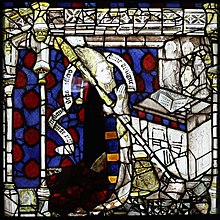Walter Skirlaw[a] (born Swine parish, Holderness,[1][2] brought up at Skirlaugh; died 1406) was an English bishop and diplomat. He was Bishop of Durham from 1388 to 1406. He was an important adviser to Richard II of England and Henry IV of England.[3]
Walter Skirlaw | |
|---|---|
| Bishop of Durham | |
 Image of Bishop Walter Skirlaw in the East Window of York Minster | |
| Appointed | 3 April 1388 |
| Term ended | 24 March 1406 |
| Predecessor | John Fordham |
| Successor | Thomas Langley |
| Previous post(s) | Bishop of Coventry and Lichfield Bishop of Bath and Wells |
| Orders | |
| Consecration | 14 January 1386 |
| Personal details | |
| Born | |
| Died | 24 March 1406 |
| Denomination | Roman Catholic |
Life
editSkirlaw was Archdeacon of the East Riding from 1359 to 1385[4] and Archdeacon of Northampton from 1381.[5] In 1382, he was given custody of the privy seal, filling the office of Lord Privy Seal, which office he held until 1386.[6]: 95 He was elected Bishop of Coventry and Lichfield on 28 June 1385, and consecrated on 14 January 1386.[6]: 253 [7] Then he was translated to be Bishop of Bath and Wells on 18 August 1386.[6]: 228 On 3 April 1388, he was once again transferred, this time to the see of Durham.[6]: 242 He would have become Archbishop of York in 1398, but Richard II over-ruled the cathedral chapter, insisting on Richard le Scrope.[8]
Skirlaw was employed on diplomatic missions to Italy in 1381–3,[9] to Calais to negotiate with the French in 1388,[10] and to the Scots. He died on 24 March 1406.[6]: 242
Skirlaw is described as "a munificent prelate. He built bridges at Shincliffe, Bishop Auckland, and Yarm; a refuge tower, a beautiful chapter-house (now in ruins) at Howden; and was a large contributor to the expense of building the central tower of York Cathedral".[11]
During his episcopacy much was added to Durham Cathedral, including its cloisters.[12] He is portrayed in the east stained-glass window in York Minster,[13] which he had made.[14]
Notes
edit- ^ Also Walter de Skirlaw, Walter Skirclaw, Walter Skirlaugh, Walter Shirlagh, or Walter Skarlawe
Citations
edit- ^ Secrets of Hylton Castle accessed on 23 August 2007
- ^ A History of the County of East Riding: Swine Parish accessed on 23 August 2007
- ^ The Fading Years of the Prince Bishops accessed on 23 August 2007
- ^ British History – Archdeacons of the East Riding, 1300–1541
- ^ Archdeacons of Northampton accessed on 23 August 2007
- ^ a b c d e Fryde, et al. Handbook of British Chronology
- ^ Bishops of Coventry and Lichfield accessed on 23 August 2007
- ^ Welcome to York Minster accessed on 23 August 2007
- ^ Concise Dictionary of National Biography
- ^ May McKisack, The Fourteenth Century, p. 463.
- ^ J. E. Bygate, Bell's Cathedrals: The Cathedral Church of Durham, Gutenberg text.
- ^ Durham Cathedral Historical Survey accessed on 23 August 2007
- ^ Vidimus no. 6 (April 2007): Panel of the Month accessed on 23 August 2007
- ^ York Minster: The Great East Window accessed on 7 September 2007
References
edit- Archdeacons of Northampton
- Bishops of Coventry and Lichfield
- Bygate, J. E. Bell's Cathedrals: The Cathedral Church of Durham, Gutenberg text
- Concise Dictionary of National Biography
- Durham Cathedral Historical Survey
- The Fading Years of the Prince Bishops
- Fryde, E. B.; Greenway, D. E.; Porter, S.; Roy, I. (1996). Handbook of British Chronology (Third revised ed.). Cambridge: Cambridge University Press. ISBN 0-521-56350-X.
- Glynne Jarratt The Life of Walter Skirlaw: Medieval Diplomat and Prince Bishop of Durham 2004
- A History of the County of East Riding: Swine Parish
- McKisack, May The Fourteenth Century
- Secrets of Hylton Castle
- Vidimus no. 6 (April 2007): Panel of the Month
- Welcome to York Minster